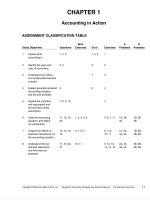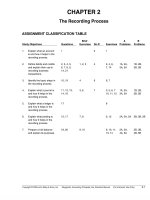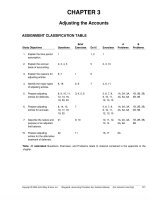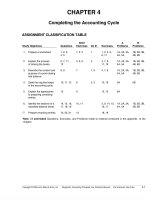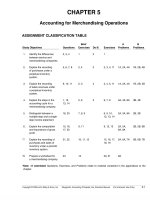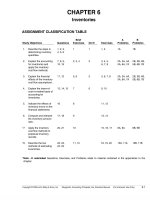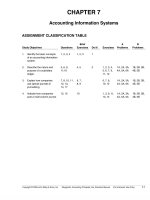Solution manual accounting principles 8e by kieso ch02
Bạn đang xem bản rút gọn của tài liệu. Xem và tải ngay bản đầy đủ của tài liệu tại đây (295.05 KB, 56 trang )
CHAPTER 2
The Recording Process
ASSIGNMENT CLASSIFICATION TABLE
Brief
Exercises
A
Problems
B
Problems
1A, 2A,
3A, 5A
1B, 2B,
3B, 5B
1A, 2A,
3A, 5A
1B, 2B,
3B, 5B
9, 12
2A, 3A, 5A
2B, 3B, 5B
9, 10, 11,
13, 14
2A, 3A,
4A, 5A
2B, 3B,
4B, 5B
Study Objectives
Questions
Exercises
1.
Explain what an account
is and how it helps in the
recording process.
1
2.
Define debits and credits
and explain their use in
recording business
transactions.
2, 3, 4, 5, 6,
7, 8, 9, 14
1, 2, 5
2, 4, 6,
7, 14
3.
Identify the basic steps in
the recording process.
10, 19
4
6, 7
4.
Explain what a journal is
and how it helps in the
recording process.
11, 12, 13,
14, 16
3, 6
3, 5, 6, 7
10, 11, 12
5.
Explain what a ledger is
and how it helps in the
recording process.
17
6.
Explain what posting is
and how it helps in the
recording process.
15, 17
7, 8
7.
Prepare a trial balance
and explain its purposes.
18, 20
9, 10
1
8
2-1
ASSIGNMENT CHARACTERISTICS TABLE
Problem
Number
Description
Difficulty
Level
Time Allotted
(min.)
1A
Journalize a series of transactions.
Simple
20–30
2A
Journalize transactions, post, and prepare a trial balance.
Simple
30–40
3A
Journalize and post transactions, and prepare a trial balance.
Moderate
40–50
4A
Prepare a correct trial balance.
Moderate
30–40
5A
Journalize transactions, post, and prepare a trial balance.
Moderate
40–50
1B
Journalize a series of transactions.
Simple
20–30
2B
Journalize transactions, post, and prepare a trial balance.
Simple
30–40
3B
Journalize transactions, post, and prepare a trial balance.
Moderate
40–50
4B
Prepare a correct trial balance.
Moderate
30–40
5B
Journalize transactions, post, and prepare a trial balance.
Moderate
40–50
2-2
2-3
Define debits and credits and
explain their use in recording
business transactions.
Identify the basic steps in
the recording process.
Explain what a journal is and
how it helps in the recording
process.
Explain what a ledger is and
how it helps in the recording
process.
Explain what posting is and
how it helps in the recording
process.
Prepare a trial balance and
explain its purposes.
2.
3.
4.
5.
6.
7.
Broadening Your Perspective
Explain what an account
is and how it helps in the
recording process.
1.
Study Objective
P2-3A
P2-5A
P2-1B
P2-2B
P2-3B
P2-5B
Analysis
P2-4B
Synthesis
Evaluation
Comparative Analysis Communication All About You
Decision Making Ethics Case
Across the
Organization
E2-14 P2-2B Q2-20
P2-2A P2-3B BE2-10
P2-3A P2-5B E2-13
P2-4A
P2-5A
P2-2A P2-3B
P2-3A P2-5B
P2-5A
P2-2B
E2-7
E2-10
E2-11
E2-12
P2-1A
P2-2A
P2-2A P2-2B
P2-3A P2-3B
P2-5A P2-5B
P2-1B
Financial Reporting Decision Making
Across the
Organization
Exploring the Web
BE2-9
E2-9
E2-10
E2-11
Q2-18
Q2-17
E2-8
Q2-16
BE2-3
BE2-6
E2-3
E2-5
E2-6
E2-6
E2-7
E2-6
E2-7
E2-14
P2-1A
BE2-7
BE2-8
E2-9
E2-12
Q2-11
Q2-13
Q2-14
Q2-12
Q2-9
Q2-14
BE2-1
BE2-2
BE2-5
E2-2
E2-4
Application
Q2-15
Q2-17
Q2-19
BE2-4
Q2-2
Q2-3
Q2-4
Q2-5
Q2-6
Q2-7
Q2-8
Comprehension
Q2-10
Q2-1
E2-1
Knowledge
Correlation Chart between Bloom’s Taxonomy, Study Objectives and End-of-Chapter Exercises and Problems
BLOOM’S TAXONOMY TABLE
ANSWERS TO QUESTIONS
1.
A T account has the following parts: (a) the title, (b) the left or debit side, and (c) the right or credit side.
2.
Disagree. The terms debit and credit mean left and right respectively.
3.
Jeff is incorrect. The double-entry system merely records the dual effect of a transaction on the
accounting equation. A transaction is not recorded twice; it is recorded once, with a dual effect.
4.
Maria is incorrect. A debit balance only means that debit amounts exceed credit amounts in an
account. Conversely, a credit balance only means that credit amounts are greater than debit
amounts in an account. Thus, a debit or credit balance is neither favorable nor unfavorable.
5.
(a) Asset accounts are increased by debits and decreased by credits.
(b) Liability accounts are decreased by debits and increased by credits.
(c) Revenues and owner’s capital are increased by credits and decreased by debits. Expenses
and owner’s drawing are increased by debits and decreased by credits.
6.
(a) Accounts Receivable—debit balance.
(b) Cash—debit balance.
(c) Owner’s Drawing—debit balance.
(d) Accounts Payable—credit balance.
(e) Service Revenue—credit balance.
(f) Salaries Expense—debit balance.
(g) Owner’s Capital—credit balance.
7.
(a) Accounts Receivable—asset—debit balance.
(b) Accounts Payable—liability—credit balance
(c) Equipment—asset—debit balance.
(d) Owner’s Drawing—owner’s equity—debit balance.
(e) Supplies—asset—debit balance.
8.
(a) Debit Supplies and credit Accounts Payable.
(b) Debit Cash and credit Notes Payable.
(c) Debit Salaries Expense and credit Cash.
9.
(1)
(2)
(3)
(4)
(5)
(6)
10.
Cash—both debit and credit entries.
Accounts Receivable—both debit and credit entries.
Owner’s Drawing—debit entries only.
Accounts Payable—both debit and credit entries.
Salaries Expense—debit entries only.
Service Revenue—credit entries only.
The basic steps in the recording process are:
(1) Analyze each transaction for its effect on the accounts.
(2) Enter the transaction information in a journal.
(3) Transfer the journal information to the appropriate accounts in the ledger.
2-4
Questions Chapter 2 (Continued)
11.
The advantages of using the journal in the recording process are:
(1) It discloses in one place the complete effects of a transaction.
(2) It provides a chronological record of all transactions.
(3) It helps to prevent or locate errors because the debit and credit amounts for each entry can
be easily compared.
12.
(a)
(b)
13.
When three or more accounts are required in one journal entry, the entry is referred to as a
compound entry. An example of a compound entry is the purchase of equipment, part of which is
paid for with cash and the remainder is on account.
14.
(a)
(b)
15.
The advantage of the last step in the posting process is to indicate that the item has been posted.
16.
(a) Cash.............................................................................................................
Hector Molina, Capital....................................................................
(Invested cash in the business)
(b)
(c)
(d)
17.
The debit should be entered first.
The credit should be indented.
No, debits and credits should not be recorded directly in the ledger.
The advantages of using the journal are:
1. It discloses in one place the complete effects of a transaction.
2. It provides a chronological record of all transactions.
3. It helps to prevent or locate errors because the debit and credit amounts for each entry
can be easily compared.
9,000
9,000
Prepaid Insurance .....................................................................................
Cash ..................................................................................................
(Paid one-year insurance policy)
800
Supplies.......................................................................................................
Accounts Payable ...........................................................................
(Purchased supplies on account)
2,000
Cash.............................................................................................................
Service Revenue.............................................................................
(Received cash for services rendered)
7,500
800
2,000
7,500
(a) The entire group of accounts maintained by a company, including all the asset, liability, and
owner’s equity accounts, is referred to collectively as the ledger.
(b) A chart of accounts is a list of accounts and the account numbers that identify their location in
the ledger. The chart of accounts is important, particularly for a company that has a large number
of accounts, because it helps organize the accounts and identify their location in the ledger.
The numbering system used to identify the accounts usually starts with the balance sheet
accounts and follows with the income statement accounts.
2-5
Questions Chapter 2 (Continued)
18.
A trial balance is a list of accounts and their balances at a given time. The primary purpose of a
trial balance is to prove (check) that the debits equal the credits after posting. A trial balance also
facilitates the discovery of errors in journalizing and posting. In addition, it is useful in preparing
financial statements.
19.
No, Jim is not correct. The proper sequence is as follows:
(b) Business transaction occurs.
(c) Information entered in the journal.
(a) Debits and credits posted to the ledger.
(e) Trial balance is prepared.
(d) Financial statements are prepared.
20.
(a)
(b)
The trial balance would balance.
The trial balance would not balance.
2-6
SOLUTIONS TO BRIEF EXERCISES
BRIEF EXERCISE 2-1
1.
2.
3.
4.
5.
6.
Accounts Payable
Advertising Expense
Service Revenue
Accounts Receivable
A. J. Ritter, Capital
A. J. Ritter, Drawing
(a)
Debit
Effect
Decrease
Increase
Decrease
Increase
Decrease
Increase
(b)
Credit
Effect
Increase
Decrease
Increase
Decrease
Increase
Decrease
(c)
Normal
Balance
Credit
Debit
Credit
Debit
Credit
Debit
BRIEF EXERCISE 2-2
June 1
2
3
12
Account Debited
Cash
Equipment
Rent Expense
Accounts Receivable
Account Credited
Hank Norris, Capital
Accounts Payable
Cash
Service Revenue
BRIEF EXERCISE 2-3
June 1
2
3
12
Cash..................................................................................
Hank Norris, Capital ...........................................
5,000
Equipment ......................................................................
Accounts Payable ...............................................
900
Rent Expense ................................................................
Cash.........................................................................
800
Accounts Receivable ..................................................
Service Revenue..................................................
300
2-7
5,000
900
800
300
BRIEF EXERCISE 2-4
The basic steps in the recording process are:
1.
Analyze each transaction. In this step, business documents are examined
to determine the effects of the transaction on the accounts.
2.
Enter each transaction in a journal. This step is called journalizing and
it results in making a chronological record of the transactions.
3.
Transfer journal information to ledger accounts. This step is called
posting. Posting makes it possible to accumulate the effects of
journalized transactions on individual accounts.
BRIEF EXERCISE 2-5
(a)
Aug.
Effect on Accounting
Equation
(b)
Debit-Credit Analysis
1
The asset Cash is increased;
the owner’s equity account
T. J. Carlin, Capital is increased.
Debits increase assets:
debit Cash $8,000.
Credits increase owner’s equity:
credit T. J. Carlin, Capital $8,000.
4
The asset Prepaid Insurance is
increased; the asset Cash is
decreased.
Debits increase assets:
debit Prepaid Insurance $1,800.
Credits decrease assets:
credit Cash $1,800.
16
The asset Cash is increased;
the revenue Service Revenue is
increased.
Debits increase assets:
debit Cash $800.
Credits increase revenues:
credit Service Revenue $800.
27
The expense Salaries Expense
is increased; the asset Cash is
decreased.
Debits increase expenses:
debit Salaries Expense $1,000.
Credits decrease assets:
credit Cash $1,000.
2-8
BRIEF EXERCISE 2-6
Aug. 1
4
16
27
Cash ..................................................................................
T. J. Carlin, Capital ..............................................
8,000
Prepaid Insurance ........................................................
Cash .........................................................................
1,800
Cash ..................................................................................
Service Revenue ..................................................
800
Salaries Expense ..........................................................
Cash .........................................................................
1,000
8,000
1,800
800
1,000
BRIEF EXERCISE 2-7
Cash
5/12
2,400
5/15
3,000
Ending Bal. 5,400
5/5
Accounts Receivable
5,000 5/12
Service Revenue
5/5
5,000
5/15
3,000
Ending Bal. 8,000
2,400
Ending Bal. 2,600
BRIEF EXERCISE 2-8
Cash
Date
May 12
15
Explanation
Ref.
J1
J1
2-9
Debit
2,400
3,000
Credit
Balance
2,400
5,400
BRIEF EXERCISE 2-8 (Continued)
Accounts Receivable
Date
Explanation
May 5
12
Ref.
J1
J1
Debit
5,000
Service Revenue
Date
Explanation
May 5
15
Ref.
J1
J1
Debit
Credit
2,400
Balance
5,000
2,600
Credit
5,000
3,000
Balance
5,000
8,000
Debit
$ 8,800
3,000
17,000
Credit
BRIEF EXERCISE 2-9
CLELAND COMPANY
Trial Balance
June 30, 2008
Cash .........................................................................................
Accounts Receivable..........................................................
Equipment ..............................................................................
Accounts Payable................................................................
Cleland, Capital ....................................................................
Cleland, Drawing..................................................................
Service Revenue ..................................................................
Salaries Expense .................................................................
Rent Expense ........................................................................
2-10
$ 9,000
20,000
1,200
8,000
6,000
1,000
$37,000
$37,000
BRIEF EXERCISE 2-10
KWUN COMPANY
Trial Balance
December 31, 2008
Cash ..........................................................................................
Prepaid Insurance ................................................................
Accounts Payable ................................................................
Unearned Revenue...............................................................
P. Kwun, Capital....................................................................
P. Kwun, Drawing .................................................................
Service Revenue ...................................................................
Salaries Expense ..................................................................
Rent Expense.........................................................................
2-11
Debit
$14,800
3,500
Credit
$ 3,000
2,200
13,000
4,500
25,600
18,600
2,400
$43,800
$43,800
SOLUTIONS TO EXERCISES
EXERCISE 2-1
1.
False. An account is an accounting record of a specific asset, liability,
or owner’s equity item.
2.
False. An account shows increases and decreases in the item it relates to.
3.
False. Each asset, liability, and owner’s equity item has a separate
account.
4.
False. An account has a left, or debit side, and a right, or credit side.
5.
True.
2-12
Asset
Liability
Owner’s
Equity
20
23
28
9
Owner’s
Equity
Asset
3
16
Asset
Jan. 2
Asset
Asset
Transaction
11
(a)
Basic
Type
2-13
D. Reyes,
Drawing
Accounts
Payable
Cash
Advertising
Expense
Accounts
Receivable
Supplies
Equipment
Cash
(b)
Specific
Account
Increase
Decrease
Increase
Increase
Increase
Increase
Increase
Increase
Effect
(c)
Account Debited
Debit
Credit
Debit
Debit
Debit
Debit
Debit
Debit
(d)
Normal
Balance
Asset
Asset
Asset
Asset
Owner’s
Equity
Liability
Asset
Owner’s
Equity
(a)
Basic
Type
Cash
Cash
Accounts
Receivable
Cash
Service
Revenue
Accounts
Payable
Cash
D. Reyes,
Capital
(b)
Specific
Account
Decrease
Decrease
Decrease
Decrease
Increase
Increase
Decrease
Increase
Effect
(c)
Account Credited
Debit
Debit
Debit
Debit
Credit
Credit
Debit
Credit
(d)
Normal
Balance
EXERCISE 2-2
EXERCISE 2-3
General Journal
Date
Account Titles and Explanation
Jan. 2
Cash ............................................................
D. Reyes, Capital............................
10,000
Equipment.................................................
Cash ...................................................
4,000
Supplies.....................................................
Accounts Payable..........................
500
Accounts Receivable.............................
Service Revenue ............................
1,800
Advertising Expense .............................
Cash ...................................................
200
Cash ............................................................
Accounts Receivable....................
700
Accounts Payable...................................
Cash ...................................................
300
D. Reyes, Drawing ..................................
Cash ...................................................
1,000
3
9
11
16
20
23
28
Ref.
Debit
J1
Credit
10,000
4,000
500
1,800
200
700
300
1,000
EXERCISE 2-4
Oct. 1
Debits increase assets: debit Cash $15,000.
Credits increase owner’s equity: credit Pete Hanshew, Capital
$15,000.
2
No transaction.
3
Debits increase assets: debit Office Furniture $1,900.
Credits increase liabilities: credit Accounts Payable $1,900.
2-14
EXERCISE 2-4 (Continued)
Oct. 6
Debits increase assets: debit Accounts Receivable $3,200.
Credits increase revenues: credit Service Revenue $3,200.
27
Debits decrease liabilities: debit Accounts Payable $700.
Credits decrease assets: credit Cash $700.
30
Debits increase expenses: debit Salaries Expense $2,500.
Credits decrease assets: credit Cash $2,500.
EXERCISE 2-5
General Journal
Date
Oct. 1
Account Titles and Explanation
Cash.............................................................
Pete Hanshew, Capital ................
Ref.
Debits
15,000
15,000
2
No entry.
3
Office Furniture........................................
Accounts Payable.........................
1,900
Accounts Receivable .............................
Service Revenue ...........................
3,200
Accounts Payable ...................................
Cash ..................................................
700
Salaries Expense.....................................
Cash ..................................................
2,500
6
27
30
2-15
Credit
1,900
3,200
700
2,500
EXERCISE 2-6
(a)
1.
2.
3.
Increase the asset Cash, increase the liability Notes Payable.
Increase the asset Computer, decrease the asset Cash.
Increase the asset Supplies, increase the liability Accounts Payable.
(b)
1.
Cash..............................................................................
Notes Payable ...................................................
Computer ....................................................................
Cash......................................................................
Supplies ......................................................................
Accounts Payable ............................................
2.
3.
5,000
5,000
2,500
2,500
700
700
EXERCISE 2-7
(a)
Assets = Liabilities + Owners’ Equity
1. +
+
(Investment)
2. –
–
(Expense)
3. +
+
(Revenue)
4. –
–
(Drawings)
(b)
1.
2.
3.
4.
Cash..............................................................................
A. Rowand, Capital ..........................................
Rent Expense ............................................................
Cash......................................................................
Accounts Receivable ..............................................
Consulting Revenue........................................
A. Rowand, Drawing................................................
Cash......................................................................
4,000
4,000
1,100
1,100
5,200
5,200
700
700
EXERCISE 2-8
1.
2.
3.
4.
5.
False. The general ledger contains all the asset, liability, and owner’s
equity accounts.
True.
False. The accounts in the general ledger are arranged in financial
statement order: first the assets, then the liabilities, owner’s capital,
owner’s drawing, revenues, and expenses.
True.
False. The general ledger is not a book of original entry; transactions
are first recorded in the general journal, then in the general ledger.
2-16
EXERCISE 2-9
(a)
Aug. 1
10
31
Bal.
Cash
5,000 Aug. 12
2,400
900
7,300
Accounts Receivable
Aug. 25
1,600 Aug. 31
Bal.
700
Notes Payable
Aug. 12
1,000
Teresa Gonzalez, Capital
Aug. 1
5,000
900
Service Revenue
Aug. 10
25
Bal.
Office Equipment
Aug. 12
5,000
(b)
4,000
2,400
1,600
4,000
TERESA GONZALEZ, INVESTMENT BROKER
Trial Balance
August 31, 2008
Cash .....................................................................................
Accounts Receivable......................................................
Office Equipment.............................................................
Notes Payable...................................................................
Teresa Gonzalez, Capital ..............................................
Service Revenue ..............................................................
Debit
$ 7,300
700
5,000
$13,000
2-17
Credit
$ 4,000
5,000
4,000
$13,000
EXERCISE 2-10
(a)
General Journal
Date
Apr. 1
12
15
25
29
30
Account Titles and Explanation
Ref.
Cash ..............................................................
J. Simon, Capital..................................
(Owner’s investment of
cash in business)
Debit
15,000
15,000
Cash ..............................................................
Service Revenue ..................................
(Received cash for
services provided)
900
Salaries Expense ......................................
Cash .........................................................
(Paid salaries to date)
600
Accounts Payable.....................................
Cash .........................................................
(Paid creditors on account)
1,500
Cash ..............................................................
Accounts Receivable..........................
(Received cash in payment
of account)
400
Cash ..............................................................
Unearned Revenue..............................
(Received cash for future
services)
1,000
2-18
Credit
900
600
1,500
400
1,000
EXERCISE 2-10 (Continued)
(b)
SIMON LANDSCAPING COMPANY
Trial Balance
April 30, 2008
Cash.......................................................................................
Accounts Receivable .......................................................
Supplies................................................................................
Accounts Payable .............................................................
Unearned Revenue ...........................................................
J. Simon, Capital ...............................................................
Service Revenue................................................................
Salaries Expense...............................................................
Debit
$15,200
2,800
1,800
Credit
$
300
1,000
15,000
4,100
600
$20,400
$20,400
EXERCISE 2-11
(a) Oct. 1 Cash .......................................................................
Heerey, Capital............................................
(Owner’s investment of cash in
business)
5,000
10 Cash .......................................................................
Service Revenue ........................................
(Received cash for services
provided)
650
10 Cash .......................................................................
Notes Payable .............................................
(Obtained loan from bank)
4,000
20 Cash .......................................................................
Accounts Receivable................................
(Received cash in payment of
account)
500
20 Accounts Receivable........................................
Service Revenue ........................................
(Billed clients for services
provided)
940
2-19
5,000
650
4,000
500
940
EXERCISE 2-11 (Continued)
(b)
HEEREY CO.
Trial Balance
October 31, 2008
Cash ................................................................................
Accounts Receivable.................................................
Supplies .........................................................................
Furniture ........................................................................
Notes Payable..............................................................
Accounts Payable.......................................................
Heerey, Capital ............................................................
Heerey, Drawing..........................................................
Service Revenue .........................................................
Store Wages Expense ...............................................
Rent Expense ...............................................................
Debit
$ 9,200
1,240
400
2,000
Credit
$ 4,000
500
7,000
300
2,390
500
250
$13,890
$13,890
EXERCISE 2-12
(a)
General Journal
Date
Sept. 1
5
25
30
Account Titles and Explanation
Cash ...........................................................
Tina Cordero, Capital ..................
Ref.
101
301
Debit
10,000
Equipment ................................................
Cash ..................................................
Accounts Payable.........................
157
101
201
12,000
Accounts Payable..................................
Cash ..................................................
201
101
3,000
Tina Cordero, Drawing .........................
Cash ..................................................
306
101
500
2-20
J1
Credit
10,000
5,000
7,000
3,000
500
EXERCISE 2-12 (Continued)
(b)
Cash
Date
Sept. 1
5
25
30
Explanation
Equipment
Date
Explanation
Sept. 5
Accounts Payable
Date
Explanation
Sept. 5
25
Tina Cordero, Capital
Date
Explanation
Sept. 1
Tina Cordero, Drawing
Date
Explanation
Sept. 30
Ref.
J1
J1
J1
J1
Ref.
J1
Ref.
J1
J1
Ref.
J1
Ref.
J1
2-21
Debit
10,000
Credit
5,000
3,000
500
Debit
12,000
Debit
Credit
No. 157
Balance
12,000
Credit
7,000
No. 201
Balance
7,000
4,000
3,000
Debit
Debit
500
No. 101
Balance
10,000
5,000
2,000
1,500
Credit
10,000
Credit
No. 301
Balance
10,000
No. 306
Balance
500
EXERCISE 2-13
Error
1.
2.
3.
4.
5.
6.
(a)
In Balance
No
Yes
Yes
No
Yes
No
(b)
Difference
$400
—
—
300
—
18
(c)
Larger Column
Debit
—
—
Credit
—
Credit
EXERCISE 2-14
SANFORD DELIVERY SERVICE
Trial Balance
July 31, 2008
Debit
Cash ($82,907 – Debit total without Cash
$66,340) ..............................................................................
Accounts Receivable..........................................................
Prepaid Insurance ...............................................................
Delivery Equipment.............................................................
Notes Payable.......................................................................
Accounts Payable................................................................
Salaries Payable ..................................................................
Sanford, Capital ...................................................................
Sanford, Drawing.................................................................
Service Revenue ..................................................................
Salaries Expense .................................................................
Repair Expense ....................................................................
Gas and Oil Expense ..........................................................
Insurance Expense .............................................................
2-22
Credit
$16,567
7,642
1,968
49,360
$18,450
8,396
815
44,636
700
10,610
4,428
961
758
523
$82,907
$82,907
SOLUTIONS TO PROBLEMS
PROBLEM 2-1A
Date
Account Titles and Explanation
Apr. 1
Cash.................................................................
C. J. Mendez, Capital ........................
(Owner’s investment of cash
in business)
40,000
Land .................................................................
Cash .......................................................
(Purchased land for cash)
30,000
Advertising Expense ..................................
Accounts Payable ..............................
(Incurred advertising
expense on account)
1,800
Salaries Expense .........................................
Cash .......................................................
(Paid salaries)
1,500
4
8
11
Ref.
Debit
40,000
30,000
1,800
1,500
12
No entry—Not a transaction.
13
Prepaid Insurance .......................................
Cash .......................................................
(Paid for one-year
insurance policy)
1,500
C. J. Mendez, Drawing ...............................
Cash .......................................................
(Withdrew cash for personal
use)
1,000
Cash.................................................................
Admission Revenue ..........................
(Received cash for services
provided)
5,700
17
20
2-23
J1
Credit
1,500
1,000
5,700
PROBLEM 2-1A (Continued)
Date
Account Titles and Explanation
Apr. 25
Cash ...............................................................
Unearned Admission Revenue.........
(Received cash for future
services)
2,500
Cash ...............................................................
Admission Revenue .........................
(Received cash for services
provided)
8,900
Accounts Payable......................................
Cash.......................................................
(Paid creditor on account)
900
30
30
2-24
Ref.
Debit
Credit
2,500
8,900
900
PROBLEM 2-2A
(a)
Date
Account Titles and Explanation
Ref.
Debit
May 1
Cash.................................................................
Jane Kent, Capital..............................
(Owner’s investment of cash
in business)
101
301
25,000
25,000
2
No entry—not a transaction.
3
Supplies..........................................................
Accounts Payable..............................
(Purchased supplies on
account)
126
201
2,500
Rent Expense................................................
Cash .......................................................
(Paid office rent)
729
101
900
Accounts Receivable .................................
Service Revenue ................................
(Billed client for services
provided)
112
400
2,100
Cash.................................................................
Unearned Revenue ............................
(Received cash for future
services)
101
205
3,500
Cash.................................................................
Service Revenue ................................
(Received cash for services
provided)
101
400
1,200
Salaries Expense .........................................
Cash .......................................................
(Paid salaries)
726
101
2,000
7
11
12
17
31
2-25
J1
Credit
2,500
900
2,100
3,500
1,200
2,000
